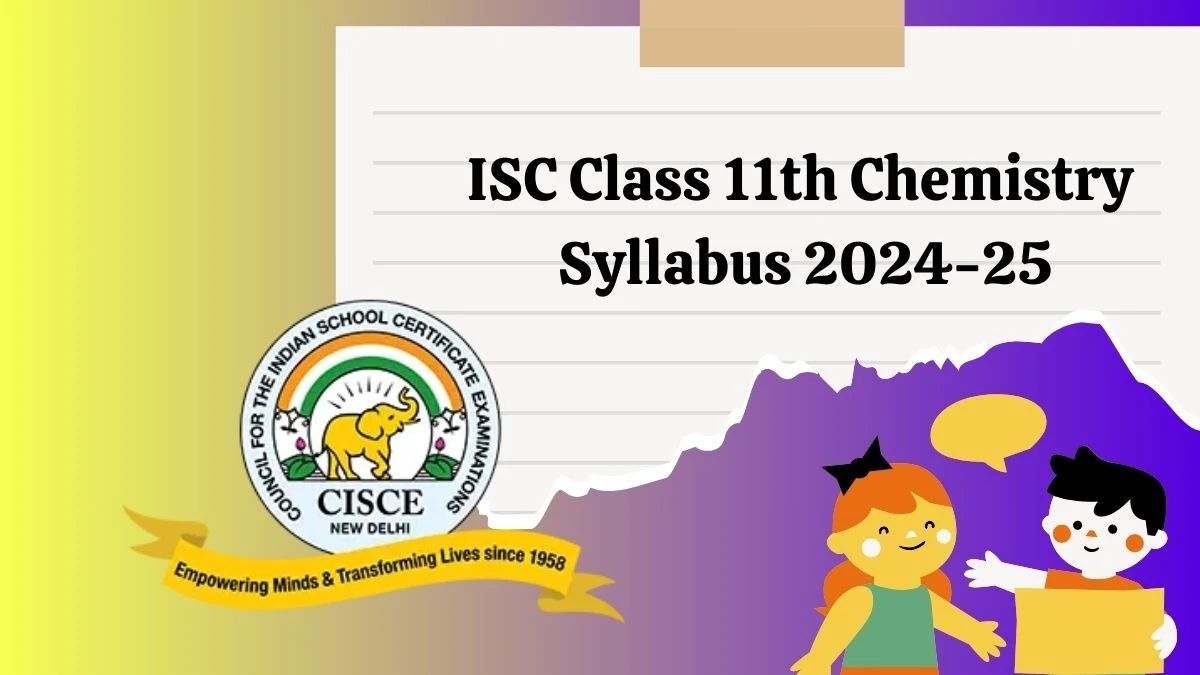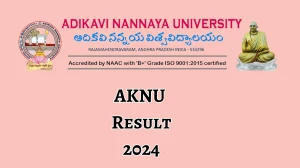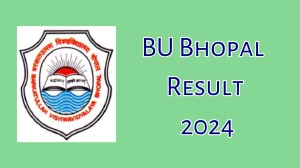- Rojgarlive »
- Education »
- ISC Class 11th Chemistry Syllabus 2024-25 @ cisce.org Check and PDF Here
ISC Class 11th Chemistry Syllabus 2024-25 @ cisce.org Check and PDF Here
by Keerthika
Updated May 14, 2024

ISC Class 11th Chemistry Syllabus 2024-25 @ cisce.org
The ISC board has recently unveiled the updated syllabus for Class 11 Chemistry for the academic session 2024-25. This article provides insights on how to download the syllabus in PDF format. The syllabus encompasses the course structure, offering an overview of the chapters to be covered throughout the academic year. Additionally, it outlines project work requirements and practical details, emphasizing the practical components essential alongside written examinations. The information presented is sourced directly from the official ISC website, ensuring its reliability and trustworthiness.
Check - ISC Class 11th Chemistry Syllabus 2024-25
Check - ISC Class 11th Chemistry Syllabus 2024-25
PAPER I- THEORY: 70 Marks
|
S. No. |
UNIT |
TOTAL WEIGHTAGE |
|
1 |
Some Basic Concepts of Chemistry |
Physical Chemistry 41 Marks |
|
2 |
Structure of Atom |
|
|
3 |
Classification of Elements and Periodicity inProperties |
|
|
4 |
Chemical Bonding and MolecularStructure |
|
|
5 |
Chemical Thermodynamics |
|
|
6 |
Equilibrium |
|
|
7 |
Redox Reactions |
Inorganic Chemistry 6 Marks |
|
8 |
Organic Chemistry: Some basic Principles andTechniques |
Organic Chemistry 23 Marks |
|
9 |
Hydrocarbons |
|
|
TOTAL |
70 Marks |
|
ISC Class 11 Chemistry Syllabus 2024-25
The Chemistry curriculum for ISC Class 11 for the year 2024-25 has been officially released by the board. Students can refer to the table below for more understanding regarding the course structure:
|
1. Some Basic Concepts of Chemistry |
|
General introduction: Importance and scope of chemistry. Study of matter. Understanding laws of chemical combination. Dalton's atomic theory: concept of elements, atoms and molecules. Isotopic (atomic) and molecular masses, mole concept and molar mass, percentage composition, empirical and molecular formula. Stoichiometry and calculations based on chemical reactions. |
|
2. Structure of Atom |
|
Discovery of fundamental particles electron, proton and neutron), atomic number, isotopes and isobars. Thomson's model and its limitations. Rutherford's experimental model and its limitations. Dual nature of matter and light. Bohr's atomic model and its limitations (de Broglie's equation, Heisenberg’s uncertainty principle), concept of shells, subshells, orbitals. Quantum numbers, shapes of s, p and d orbitals. Rules for filling electrons in orbitals - aufbau principle, Pauli's exclusion principle and Hund's rule of maximum multiplicity. Electronic configuration of atoms, stability of half- filled and completely filled orbitals. |
|
3. Classification of Elements and Periodicity in Properties |
|
Significance of classification; study of Mendeleev’s periodic law and its limitations; Modern Periodic Law and the present form of periodic table leading to periodic trends in properties of elements - atomic radii, ionic radii, valency, ionisation enthalpy, electron gain enthalpy, electronegativity. Nomenclature of elements with atomic number greater than 100. |
|
4. Chemical Bonding and Molecular structure |
|
Valence electrons, ionic bond character, covalent bond of ionic bond, covalent bond, bond parameters, lewis structure, polar character of covalent bond, VSEPR theory, geometry of covalent molecules, valence bond theory, concept of hybridisation involving s, p and d orbitals and shapes of some simple molecules. Coordinate bond. Molecular orbital theory of homonuclear diatomic molecules (qualitative idea only). Resonance and hydrogenbond. |
|
5. Chemical Thermodynamics |
|
(i) Introduction, concepts, types of system, surroundings, extensive, intensive properties and state functions. (ii) First Law of Thermodynamics and its significance, work, heat, internal energy, enthalpy (∆U or ∆E and ∆H), heat capacity and specific heat. Hess's law of constant heat summation, enthalpy of bond dissociation, combustion, formation, atomisation, sublimation, phase transition, ionisation, solution and dilution. (iii) Second Law of Thermodynamics and its significance, spontaneity of a chemical change; Entropy, Free Energy. Inadequacy of First Law and need for Second Law; Ideas about reversible (recapitulation), spontaneous and non-spontaneous processes (iv)Third Law of Thermodynamics – statement only. |
|
6. Equilibrium |
|
(i) Chemical Equilibrium. Introduction of physical and chemical equilibrium and its characteristics Dynamic nature of equilibrium, law of mass action, equilibrium constant and factors affecting equilibrium. Le Chatelier's principle and its applications. (ii) Ionic equilibrium Introduction, electrolyte (strong and weak), non-electrolyte, ionisation, degree of ionisation of polybasic acids, acid strength, concept of pH, pH indicators, buffer solution, common ion effect (with illustrative examples). Henderson equation, hydrolysis |
|
7. Redox Reactions |
|
Concept of oxidation and reduction, redox reactions, oxidation number, change in oxidation number, balancing redox reactions (in terms of loss and gain of electrons). Applications of redox in various types of chemical reactions. |
|
8. Organic Chemistry - Some Basic Principles and Techniques |
|
General introduction, classification and IUPAC nomenclature of organic compounds and isomerism. Methods of purification, qualitative and quantitative analysis. Electron displacement in a covalent bond: inductive effect, electromeric effect, resonance and hyperconjugation. Homolytic and heterolytic bond fission of a covalent bond: free radicals, carbocations, carbanions, electrophiles and nucleophiles, types of organic reactions. |
|
9. Hydrocarbons |
|
Classification of Hydrocarbons |
|
I. Aliphatic Hydrocarbons (i) Alkanes - Nomenclature, isomerism, conformation (methane and ethane), physical properties, chemical properties including free radical mechanism of halogenation, combustion and pyrolysis. (ii) Alkenes - Nomenclature, structure of double bond (ethene), isomerism; methods of preparation; physical properties, chemical properties; addition of hydrogen, halogen, water, hydrogen halides (Markownikoff's addition and peroxide effect), ozonolysis, oxidation, mechanism of electrophilic addition. (iii)Alkynes - Nomenclature, structure of triple bond (ethyne), methods of preparation; physical properties, chemical properties: acidic character of alkynes, addition reactions - hydrogen, halogens, hydrogen halides and water. |
|
II. Aromatic Hydrocarbons Introduction, IUPAC nomenclature, benzene: resonance, aromaticity, chemical properties: mechanism of electrophilic substitution. Nitration, sulphonation, halogenation, Friedel Crafts alkylation and acylation, directive influence of functional group in monosubstituted benzene. Carcinogenicity and toxicity. |
PAPER II - PRACTICAL WORK- 15 Marks
Candidates are required to complete the following experiments:
- Basic laboratory techniques:
- Cutting a glass tube.
- Bending a glass tube.
- Drawing out a glass jet.
- Boring a cork.
- Titration: acid-base titration involving molarity. Titrations involving:
- Sodium carbonate solution/ dil H2SO4 or dil. HCl using methyl orange indicator.
- NaOH or KOH solution/ dil H2SO4 or dil. HCl using methyl orange indicator.
- Calculations involving molarity, concentration in grams L-1 / number of ions, water of crystallisation and percentage purity.
PROJECT WORK AND PRACTICAL FILE – 15 Marks
Project Work – 10 Marks
The candidate is to creatively execute one project/assignment on a selected topic of Chemistry. Teachers may assign or students may choose any one project of their choice. (Refer to the suggested topics at the end of Class XII syllabus).
Suggested Evaluation criteria:
|
Introduction / purpose |
|
Contents |
|
Analysis/ material aid (graph, data, structure, pie charts, histograms, diagrams, etc) |
|
Presentation |
|
Bibliography |
Practical File – 5 Marks
Teachers are required to assess students on the basis of the Chemistry Practical file maintained by them during the academic year.
ISC Exam Pattern
| Subject | Paper | Marks |
| English | English Language | 100 |
| Literature in English | 100 | |
| History | Theory | 80 |
| Project Work | 20 | |
| Geography | Theory | 70 |
| Practical and Project Work | 30 | |
| Economics | Theory | 80 |
| Project Work | 20 | |
| Commerce | Theory | 80 |
| Project Work | 20 | |
| Accounts |
Theory | 80 |
| Project Work | 20 | |
| Maths | Theory | 80 |
| Project Work | 20 | |
| Physics | Theory | 70 |
| Practical | 15 | |
| Project Work | 10 | |
| Practical File | 5 | |
| Chemistry | Theory | 70 |
| Practical | 15 | |
| Project Work | 10 | |
| Practical File | 5 | |
| Biology | Theory | 70 |
| Practical | 15 | |
| Project Work | 10 | |
| Practical File | 5 |
ISC Class 11th Chemistry Syllabus 2024-25? -FAQ
The ISC class 11 syllabus can be downloaded through official website, cisce.org.
The level of examination is kept easy to moderate.




